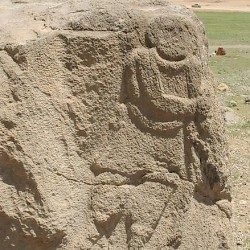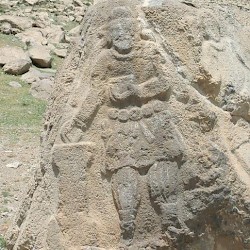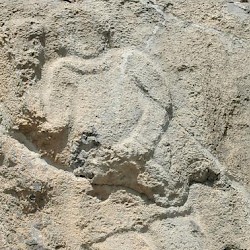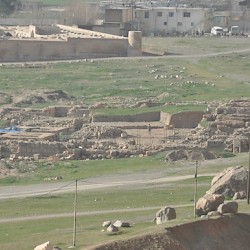Behistun, other monuments
Behistun or Bisotun: town in Iran, site of several ancient monuments, including a famous inscription by the Persian king Darius I the Great.

Alexander the Great is known to have visited Behistun but we do not know more than that he heard that Bagastâna meant "place where the gods dwell".note After his death in 323 BCE, his empire disintegrated and the eastern satrapies fell to one of his officers, Seleucus I Nicator, who founded the Seleucid Empire. Behistun, situated along a main road that was just as crowded with travelers as it had always been, remained a monumental site.
Heracles
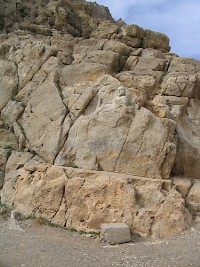
From this age, we have a nice statue of a reclining Heracles that dates back to 148 BCE, i.e., the final years of Seleucid control of the satrapy of Media. The demigod is shown quietly resting and drinking from a bowl, after performing one of his labors. (According to the Greek orator Libanius, Heracles was considered to be the ancestor of the Seleucid dynasty.) This statue was discovered in 1958, when the local road was lowered. At first, it had no head, but this was found a couple of days later. It was later stolen; what you see today, is a copy.
Parthian rock reliefs
A few years after the statue of Heracles had been created, Seleucid rule in the Iranian part of the empire collapsed. For almost four centuries, the Parthians were in control. They also left monuments at Behistun: rock reliefs and a free standing relief. The two rock reliefs are both damaged, not in the least because a seventeenth-century inscription was added in something resembling a mihrab.
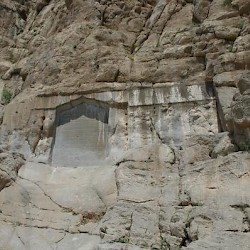 Behistun, Parthian rock reliefs |
 Behistun, Parthian relief of Mithadates II |
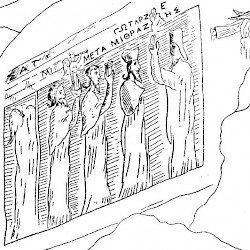 Behistun, Parthian relief of Mithradates II, drawing |
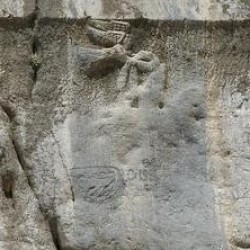 Behistun, Parthian relief of Gotarzes II defeating Meherdates |
The pictures above show the rock reliefs. In spite of the damage, one can still discern two figures, which are represented in profile, as was common in Achaemenid art. However, the inscription on top of it is in Greek and the Nikê, the winged personification of victory that (according to an old drawing) was once visible, is also in Greek style. It is not exaggerated to say that the maker of this relief, one of the oldest made for a Parthian king, tried to combine two types of art, as if to stress that the Arsacid dynasty accepted two legacies. Coinage of this age shows the same program: they show an Iranian archer and have a Greek legend.
The relief was made for king Mithradates II, who was ruler of Iran and Iraq fom 121 to 91 BCE, so the relief is just one generation younger than the little Heracles.
The drawing shows what this relief once must have looked like. As you can see, four dignitaties, arrive to salute their king. The central figure carries the Nike and one of the men seems to raise a cup, a motif not otherwise known from Iranian art - and maybe an artist's error.
The second relief, which is shown on the right-handphoto, was cut into the rock immediately to the right of the first one. It shows an equestrian fight between the victorious Parthian king Gotarzes II (39?-51) and his enemy Meherdates. Above flies a Greek Nikê with a diadem.
Free standing Parthian relief
A bit to the east of the two reliefs is a free standing rock, about 2½ meters high, on which a Parthian king is shown, pouring a libation on an altar. On two other sides, Parthian dignitaries are represented. Dress and style are Iranian, and so is the frontal representation of these men. We are now far removed from the Greek influence on the rock reliefs.
A damaged inscription on the free standing rock identifies the central figure as
Vologases, king of kings, son of Vologases, king of kings, grandson of ...
There were six rulers with this name, and at least three had a father who was called Vologases too: Vologases II (r.77-80), Vologases V (r.191-208), and Vologases VI (r.208-218). Perhaps the same applies to Vologases III (r.105-147) as well, so this information is not extremely helpful, except that it helps us date the relief to the first centuries of the common era.
Unfinished Sasanian relief
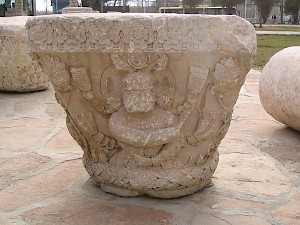
The Parthians, weakened by the military campaigns of the Roman emperor Septimius Severus, were overthrown by the Persian dynasty of the Sasanians. They built a bridge at Behistun, but it has been rebuilt several times, and only the foundations can still be called Sasanian. However, it shows that Behistun was still an important place, where new rulers wanted to show themselves. It is no coincidence that the scene of the sad story about the star-cross'd lovers Shirin and Farhad and Shirin's husband, the Sasanian king Khusrau II (r.590-628), is laid at Behistun.
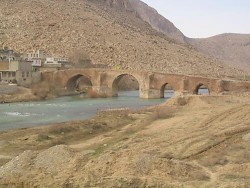
Khusrau is also connected to the last known monuments at Behistun: the unfinished palace and the unfinished relief. Khusrau's armies had ravaged the cities of Syria, sacked Jerusalem in 614 (seizing the relic of the True Cross), invaded Egypt, and even reached Constantinople. It seemed as if the Achaemenid Empire was about to be restored, and Khusrau ordered the making of brilliant rock reliefs at Taq-e Bostan and Behistun.
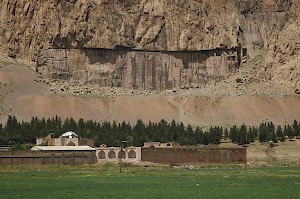
The monument at Taq-e Bostan was finished, but the Behistun relief was not: all that is visible is a piece of rock that was cleared. The Byzantine emperor Heraclius attacked the Sasanian empire and was very successful; the Persian army mutinied and Khusrau was assasinated (628). His successor Ardašir IV made peace and the relic of the True Cross was restored to Jerusalem.
After this, the two empires were an easy target for the Arabs. In 641, they invaded Iran and defeated the Sasanians at Nehavand. On their march to the east, they had taken the main road along Behistun.
